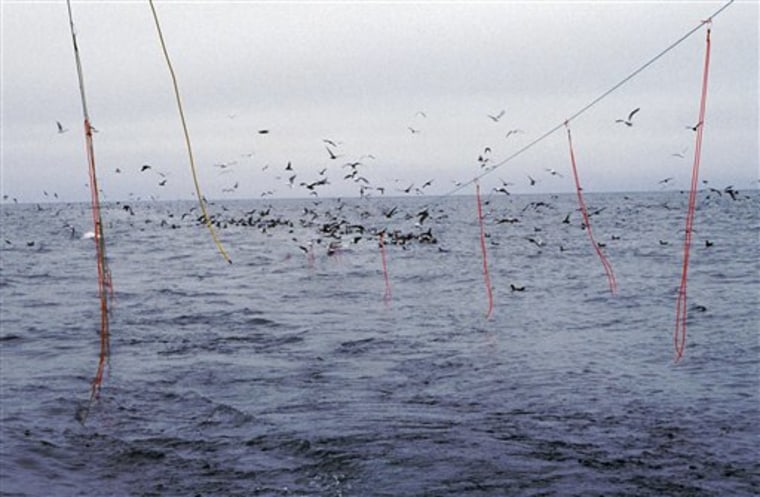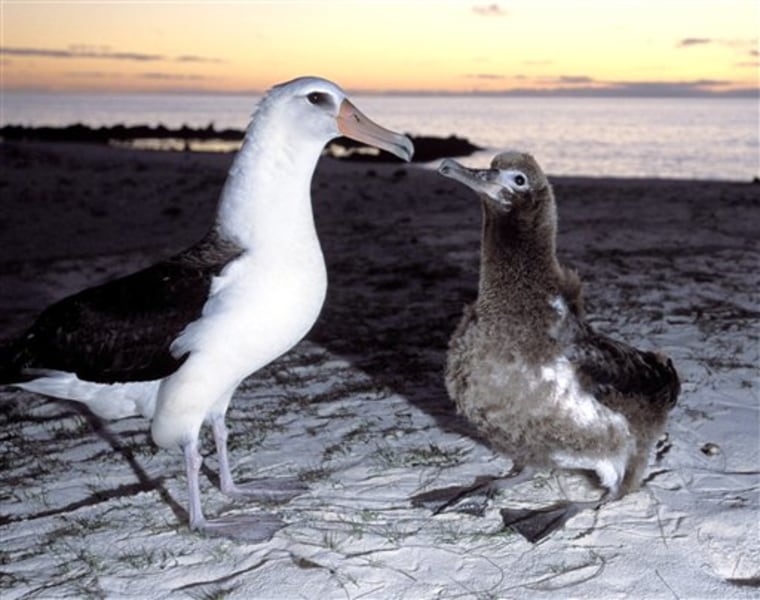Albatross looking for a free meal on the high seas often pay the price of being killed or injured going after baited hooks.
Now, fishing fleets around the world have agreed to use measures to prevent hooking albatross and other seabirds whose numbers are declining.
The measures — using streamer lines to drive birds away from boats' sterns as miles of baited hooks are being set as well as dying bait blue to conceal it in dark water — will go into effect this year in the Atlantic and Pacific oceans.
"Both of these measures are mandatory requirements for the vessels that are fishing in those areas," said Kim Rivera, national seabird coordinator for the National Oceanic and Atmospheric Administration.
Albatross are particularly vulnerable to being hooked on longlines used to catch tuna and other fish because of their lengthy search for food, which takes them across international waters.
"You have birds that are attracted to the fishing vessels because they see it as a feeding opportunity," Rivera said. "The birds congregate there. They see it as a free meal. They clue in on the baited hook and go after it."
Late last year, two commissions that govern high-seas fishing agreed to the measures, which also require fleets from more than 30 nations to abide by certain practices to avoid killing the birds. The practices will vary depending upon what works best and where, Rivera said.
Techniques that could be used for tuna and swordfish in the Atlantic include fishing at night when birds are less active, weighting fishing lines so that the baited hooks sink more quickly and using long streamers.
"Those streamers whip around and basically scare the birds away," Rivera said.
Similar techniques will be employed in the Pacific, with some longliners required to fish at night and others being prohibited from discharging fish waste at the same time as baited hooks are being set.
"There is really no one single measure that works 100 percent of the time," Rivera said.
Asian fleets on board
Nations with large fleets that have agreed to the measures include Taiwan, Japan and Korea.
In Antarctica, where the Commission on the Conservation of Antarctic Marine Living Resources became the first international organization to require the measures, as many as 6,000 albatross a year were being incidentally caught in the late 1990s.
That commission has been very successful in preventing the hooking of several types of albatross in the Antarctic, Rivera said. No albatross have been unintentionally caught there in the last two years.

In the United States, only Alaska and Hawaii require their longliners to use anti-hooking measures. NOAA is looking into whether similar measures are needed off the coasts of Washington and Oregon.
Alaska's longline fishermen began using streamer lines in the late 1990s and have found them to be very effective, said Dan Falvey, captain of the Myriad out of Sitka, who helped design the lines for smaller vessels.
Streamer lines are attached to the stern and extend out between 150 to 300 feet behind the boat. Many times vessels will use a streamer line on either end of the stern, creating a box where the longlines are set inside. Long strings of orange surgical tubing are placed every 15 or 20 feet along the streamer line with the tubing extending to the surface of the water.
Streamers akin to a 'moving fence'
"What it creates is a moving fence around the gear that is being set and the birds are afraid to cross it," Falvey said.
The new international agreement is particularly significant for one species of albatross found in the northern Pacific.
The short-tailed albatross, which breeds only in Japan, is listed as endangered. The large black-and-white birds with cream-colored heads and distinctive pink bills with a bluish tip have a worldwide population of about 2,300.
There used to be between 2 million and 5 million short-tailed albatross, but commercial feather hunting at the turn of the century devastated the population. The feathers were used primarily for bedding, quilts and coats. Eventually, it was thought the birds were extinct.
But in 1939, there was a volcanic eruption on Torishima Island, home to the breeding colony about 360 miles south of Tokyo. If it hadn't been for young birds at sea, it could have been the end for the short-tailed albatross.
